Attached files
| file | filename |
|---|---|
| 8-K - FORM 8-K - SCHLUMBERGER LIMITED/NV | h80638e8vk.htm |
Exhibit 99
| Howard Weil Energy Conference 2011 | Keynote |
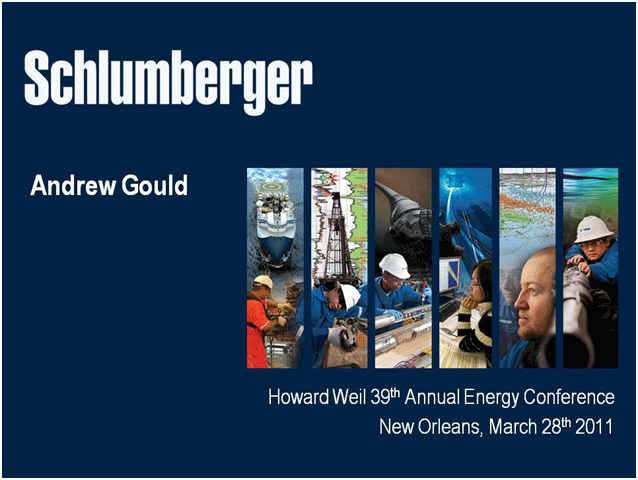
Ladies and gentlemen good morning—it’s a great pleasure to be back in New Orleans for the
39th Howard Weil Energy Conference.
In spite of the political turmoil and natural disasters that we have seen over the past two months,
I’m going to try and convince you that the fundamentals for oil and gas remain unchanged, and that
the case for investment in the premier oilfield services company has never been stronger.
To do this, I’m going to cover three topics.
First, I will review the macro environment for oil and gas, showing how this has evolved and how it
is evolving. I’ll demonstrate that the theme of increasing complexity in finding and developing
hydrocarbons remains valid, while new opportunities have arisen from technology or changed
circumstances.
Second, I will describe how Schlumberger is uniquely positioned to address industry needs through
size, technology offering, geographical presence, infrastructure, workforce, together with our
industry-leading efforts to improve operational performance.
Finally, I’m going to outline some of our ambitions for the next five years.
1
| Howard Weil Energy Conference 2011 | Keynote |
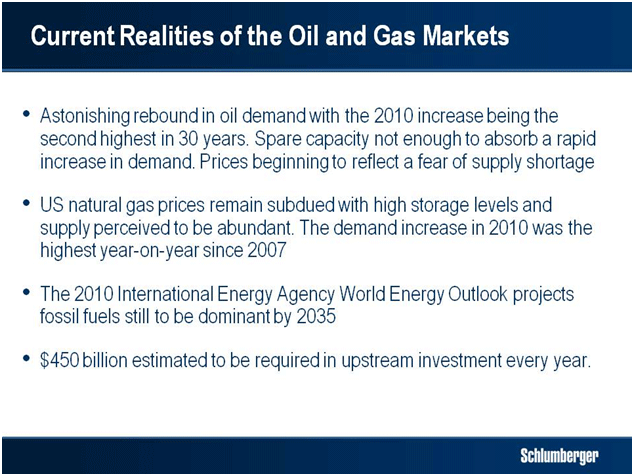
Looking at the broad picture, 2010 saw the most astonishing rebound in oil demand in recent history
with the increase of 2.8 million barrels per day being the second highest in 30 years. The average
demand increase in 2011 from the three principal forecasting agencies is for an additional 1.4
million barrels per day. While spare capacity, almost exclusively concentrated in the Middle East
OPEC countries, is significantly higher than in 2006, it is not enough to absorb a rapid increase
in demand and the rate at which new supply is added will decrease in the coming year. The absence
of Libya from this market creates additional tensions and oil prices have recently begun to reflect
a fear of supply shortage and disruption.
US natural gas prices on the other hand remain subdued with high levels of storage and the
perception that supply is abundant and can be quickly increased. Following a 1.8% decrease in
demand in 2009, the EIA has recently estimated a 5.4% increase in 2010 followed by a flat 2011 at
66.2 billion cubic feet per day. The 2010 increase is the largest year-on-year growth since 2007.
Longer term, the 2010 IEA World Energy Outlook projects fossil fuels still to be dominant by 2035,
even if low carbon policies are implemented. They also predict natural gas to show the largest
increase in absolute terms by that time.
To enable such growth in oil and gas supply, investment of some 450 billion dollars is estimated to
be needed every year in upstream activity for the next 25 years.
2
| Howard Weil Energy Conference 2011 | Keynote |
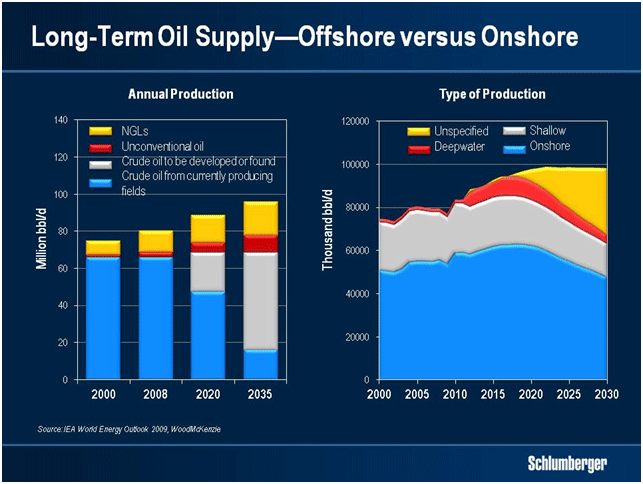
To illustrate the size of the task ahead, the IEA estimates that approximately half of the
conventional oil production needed by the end of this decade has yet to be developed or discovered.
By 2035, that figure may have increased to more than 70%.
Of this production, offshore activities—and deepwater operations in particular—merit significant
attention. In the last ten years, more than half of all new oil and gas reserves discovered
worldwide has been offshore. As a result, offshore oil could be supplying approximately one third
of the world’s needs by the late 2020s. And by then, deepwater production will have increased to
about one third of offshore supply, or approximately 10% of global supply.
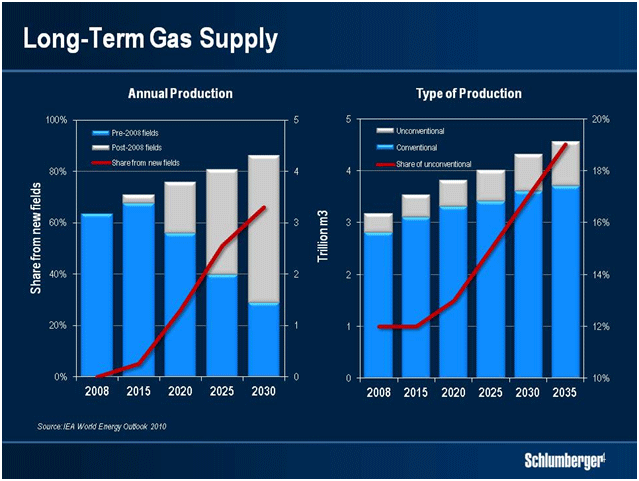
3
| Howard Weil Energy Conference 2011 | Keynote |
For natural gas, the IEA projects demand to increase by 1.4 to 1.6% per year between 2008 and 2035,
with the bulk of that increase coming from the non-OECD economies. Other forecasts are even more
bullish, projecting annual growth rates of around 2.0%. In addition, a reassessment of the energy
mix following the nuclear accident in Japan is likely to confirm higher demand growth for natural
gas.
My task today is to convince you that absent a second economic shock and a further drop in demand,
the industry will face an increasingly harder task of turning resources into reserves, and reserves
into production—particularly for conventional oil.
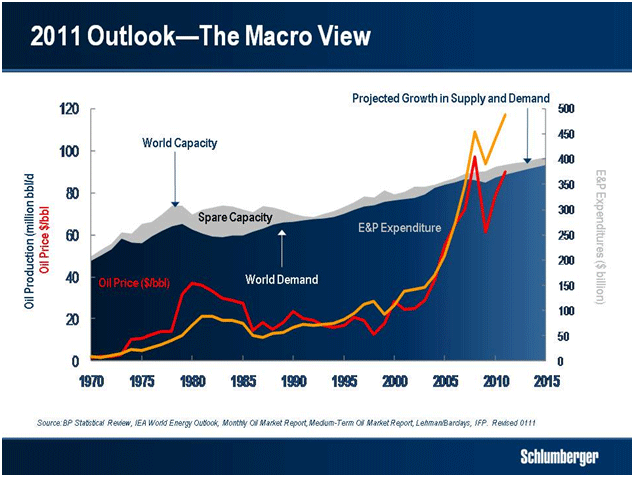
It is instructive to look at the broad context of the last decade to understand why this is so.
That decade was marked by a fundamental shift in the security of supply argument, which, having
been an OECD concern for the last hundred years, became China’s obsession, with it, and to some
extent India, now driving demand. This is the first, and undoubtedly the most important, shift of
the last decade.
The second shift of the decade was undoubtedly the emergence of Russia as the world’s single
largest producer. Following the collapse of the Soviet Union, Russian production fell to as low as
6.1 million barrels per day. In the six years following 1999 it rose by more than 3 million barrels
per day, becoming the major reason why oil prices had not risen faster earlier in the decade.
This leads me to the supply response. At the beginning of the decade when supply-demand balances
started to tighten, the industry faced its first supply challenge in 25 years. In the years
following 2003, the thin margin of excess capacity coupled with rapid price increases, led to the
explosion in exploration and production capex from $130 billion in 2000 to $500 billion in 2008—a
compound growth rate of over 18%.
4
| Howard Weil Energy Conference 2011 | Keynote |
All of this led to a period of frantic growth in activity that has had major effects on the
industry structure and I’d like now to look at some of the short- and long-term consequences.
The first, and by far the most important effect was the re-emergence of resource nationalism. This
isn’t new, but in the 2000s resource nationalism was rife. Russia sought to capture a greater share
of the rent. Venezuela closed again, and the Middle East did not open significantly. Mexico didn’t
open at all. Libya opened but recent events have showed how transitory that was. Sanctions kept
Iran and Sudan largely off limits. And after a spate of extraordinary discoveries, Brazil started
to restrict access—not to investment but to foreign operators in the pre-salt domain.
The net result is that perhaps 75% of the world’s known conventional oil reserves are closed to
international private capital today, while 60% of production originates from non-NOC operators.

The consequence of this has been to give a whole new meaning to the words “major resource holder”.
The range of national companies, both in structure and in competence is now vast. Some are major
offshore operators, such as Statoil or Petrobras, while others have mastered complex project
management, such as Saudi Aramco. Such companies are capable of competing with the best while other
NOCs are emerging with increasingly large international portfolios.
All these restrictions led the industry, particularly the IOCs and independents, to opportunities
offshore, in more remote and harsh environments, and to the heavier end of the hydrocarbon chain.
In addition, discoveries of conventional oil accumulations became smaller, and therefore more
difficult to produce economically.
5
| Howard Weil Energy Conference 2011 | Keynote |
These sources of conventional oil production are increasingly complemented by unconventional oils,
such as heavy or shale oils, which require massive projects of long duration that require huge
amounts of capital. As a result, if there is one common characteristic in the oil exploration and
development projects to be executed in the future, both for deep offshore and complex
unconventional oils, it is that they will become more difficult and more expensive to execute.
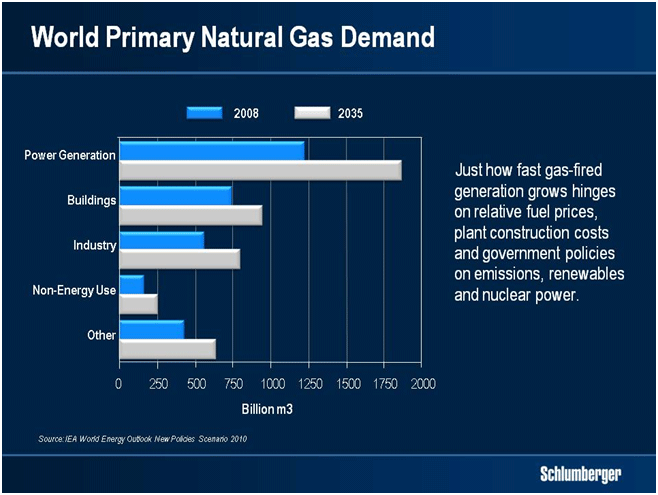
The 2000s were equally a decade of tremendous change for gas. Natural gas economics are governed by
geography and by transportation to market. Today’s multiple sources of supply should allay fears of
any rupture in supply to Western Europe, while shale gas in the USA has changed the dynamics of US
supply. And the rapid development of deposits in Australasia has changed the availability of
long-term supply for China, Korea and Japan.
However, two phenomena marked the 2000s. The first was the huge expansion in LNG capacity, which is
still increasing due to projects begun in the late 2000s and which is expected to represent 15% of
global capacity by 2020. This is essentially a play for very large companies as investments are
massive, and projects long to come to market.
6
| Howard Weil Energy Conference 2011 | Keynote |
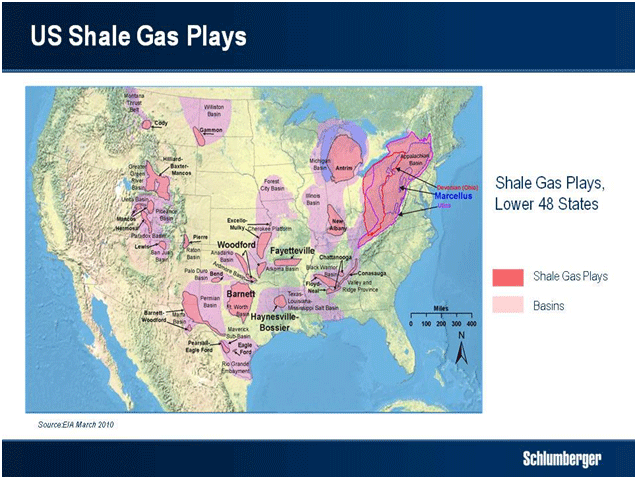
The second was the development of North American shale gas. The shale gas revolution required
technology, market forces and entrepreneurship to make its production economic. And while today’s
combination of horizontal wells and hydraulic fracturing has made certain shales economic,
technology will have to move much further to systematically extract full value from every shale as
current methods are both wasteful and expensive.
In the rest of the world, where knowledge of shales is vastly inferior to that of the US, countries
and companies are actively searching to understand the prospectivity of their own deposits. Much
remains to be done before we can be assured that the rest of the world’s shales are as prospective
as those of the United States.
I have now outlined the context for supply and demand, and indicated how the industry will focus
more and more on complex, difficult-to-reach resources. Some of that focus has already occurred as
the growth in new projects clearly shows.
7
| Howard Weil Energy Conference 2011 | Keynote |
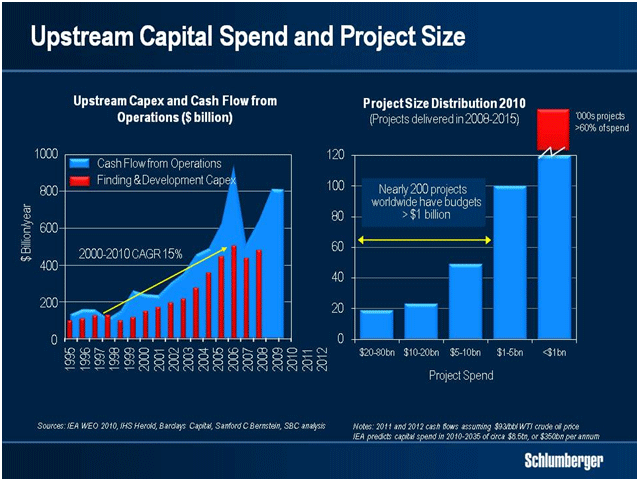
For example, the cost of new deepwater exploration and development projects in increasingly remote
locations coupled with the complex logistics associated with areas such as Russia, the Caspian and
Iraq are fundamentally changing the importance of project management and project execution. There
are now over 200 exploration and production projects worldwide that have a budget in excess of $1
billion.
In addition, it is extraordinary that NOCs and Independents now represent over 80% of total
industry capex spend. No less than 30 oil and gas companies have annual capex budgets in excess of
$4 billion—up from only 10 in 2001. While not wishing to embarrass any of my customers, I would
add that many Greenfield projects suffer significant cost overruns. Indeed, as a general rule 30%
of such projects experience budget overruns of 50%.
Clearly, the service company that can bring the best in technology, process and workforce
competency to limit such expense stands to gain the greatest advantage. In other words, the future
will all be about raising the bar on execution.
8
| Howard Weil Energy Conference 2011 | Keynote |

If I now compare our top 30 customers in 2010 to those of 2002, there has been little change. There
were and are 5 super majors. In 2010 we counted 13 NOCs, up from 12 in 2002. On the other hand,
there are 12 independents, down from 13. However, the shift in revenue between customer groups is
extraordinary. In 2002 the super majors represented 33% of the top 30. This had declined to 22% by
2010. In the same period revenues from the NOCs almost doubled, while independents declined
slightly.
However, there is another dynamic in our ability to meet our customers’ requirements. The
consequences of the Deepwater Horizon tragedy where eleven men died and which led to the largest
oil spill in US history will change some of the ways the service industry works forever.
9
| Howard Weil Energy Conference 2011 | Keynote |
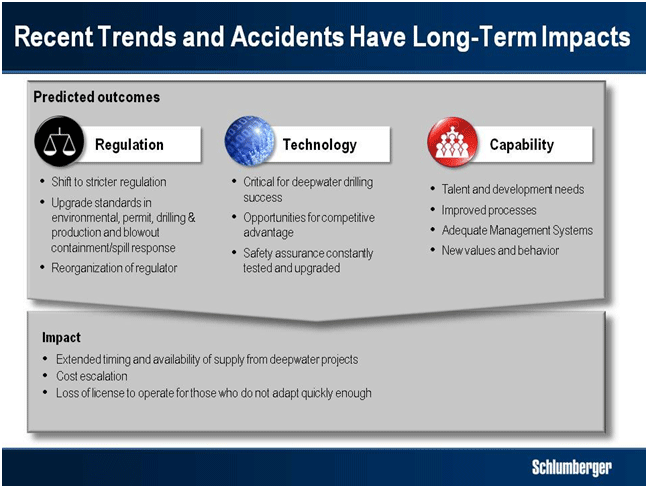
Among these, the reliability of technology as well as the operating efficiency in project planning
and execution and the regulatory consequences of Macondo will add a new dimension to offshore
operations in three areas—regulation, technology and capability. Stricter standards of regulation
will require much improved process from the service industry. Technology will be needed to improve
both safety as well as operational performance, and capability will need to be managed through
improved processes.
It is therefore essential that our technology not only address the challenges of exploration and
increased drilling intensity and the challenges of a changing customer base, larger projects, more
remote operations, increasingly complex geological settings and higher pressures and temperatures.
It must also respond to new deepwater requirements post Macondo and help mitigate higher operating
costs, particularly offshore.
I would like now to look at these technologies in more detail beginning with exploration, where our
own technology portfolio is unmatched and we are uniquely positioned to profit from increased
exploration spend.
10
| Howard Weil Energy Conference 2011 | Keynote |

Whether in seismic through WesternGeco, in openhole wireline, logging while drilling or testing we
are the leading player. Following the acquisition of the minority interest in WesternGeco in 2006,
we are now in a position to provide customers with innovative processing and interpretation
routines that allow us to move directly from seismic processing to Petrel workflow process and back
again thus helping reduce risk and move more rapidly to field development planning. This has
allowed Petrel to increase market penetration over the last year as it expands into the growing
exploration market.

The significance of this is obvious when you look at industry performance as measured by a wide
group of oil companies. This clearly shows that the world has been consuming
11
| Howard Weil Energy Conference 2011 | Keynote |
considerably more oil
than has been discovered, and the need to accelerate exploration is therefore a necessity.
Exploration will be a key driver over the near term.
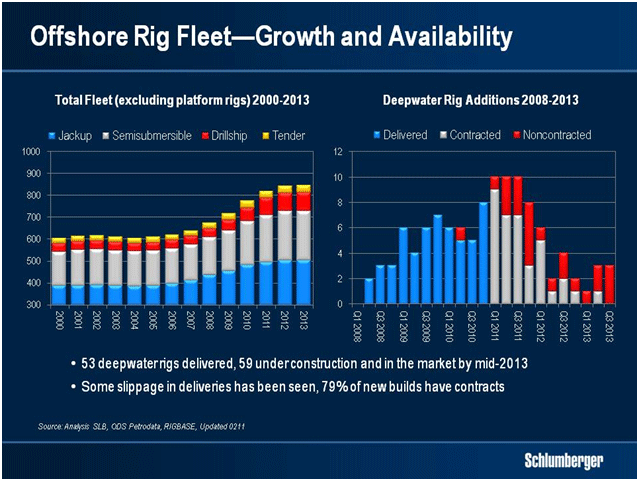
The availability of deepwater rigs will accelerate this as more deepwater provinces become active.
We have recently signed an exploration contract for an ultra deepwater rig that will drill
successively in Australia, East Timor, India, Indonesia and Mozambique. This type of roving
exploration campaign is becoming increasingly common and you can imagine that the planning and
logistics involved are extraordinarily complex. The exploration market is also one where the value
of data is increasing.
Indeed, the intensity of exploration spend has increased much faster than overall upstream cost
indexes. There are good reasons for this. Location, reservoir complexity and hydrocarbon
composition all require higher technology to be properly addressed.
12
| Howard Weil Energy Conference 2011 | Keynote |

For some time we have stressed that maintaining production and bringing new reserves on line would
require an increase in drilling intensity. The emphasis is not just on the number of wells to be
drilled, but also on their increasing complexity and cost be it for expensive deepwater wells or
for the technology required to make unconventional hydrocarbons economic through the introduction
of practices such as factory drilling.
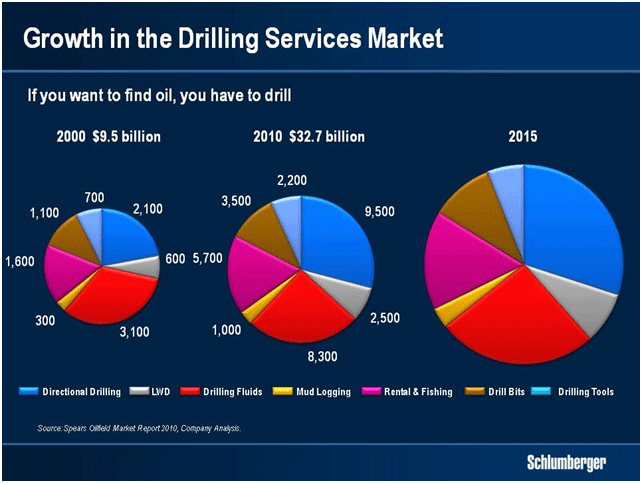
Given this context, in addition to investment in new technology, it is becoming increasingly
apparent that the old adage of the oil industry holds truer than ever. If you want to find oil you
have to drill. And if you want to produce unconventional gases or oils it is even truer.
13
| Howard Weil Energy Conference 2011 | Keynote |
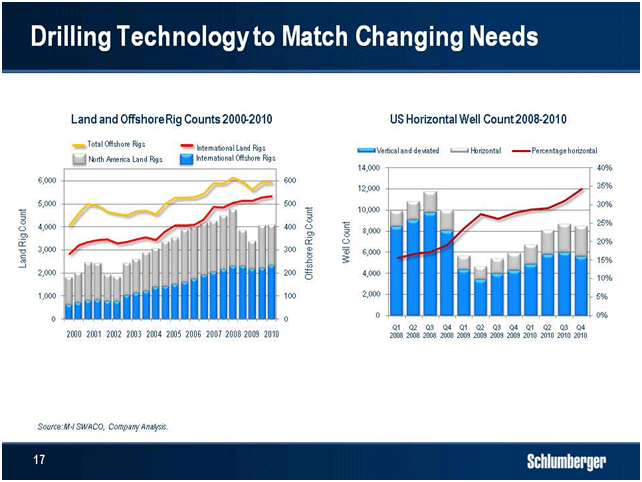
I have already referred to the increase in exploration and development offshore and in deepwater.
At the same time differing hydrocarbon types require greater degrees of drilling technology—both
to improve the reliability of operations and to reduce overall finding and development costs.
In addition to new exploration drilling technologies, drilling to help recover unconventional gases
and unconventional oils requires technologies for better extraction, lower cost and smaller
environmental footprint. The dramatic change in the North American well count from vertical to
horizontal over a very short period of time demonstrates the extent to which this change is already
underway.
Another area for increased drilling concerns those reserves already in production. Prolonging their
exploitation and increasing their recovery represents a significant opportunity and it is here that
increased drilling intensity is likely to make the biggest difference in the short to medium term.
The rehabilitation of the productive capacity in Iraq is an example that implies higher rig counts
and this pattern is likely to be increasingly seen around the world.
14
| Howard Weil Energy Conference 2011 | Keynote |

It is the technology needs for the market opportunities that I have just discussed that have led us
to the acquisitions of Smith and Geoservices.
We believe that the combination of our own leading positions in directional drilling,
measurement-while-drilling and logging-while-drilling with Smith’s positions in drill bits,
drilling tools and drilling fluids through M-I SWACO together with our joint venture with National
Oilwell Varco for wired drillpipe will allow us to help customers with the three components of the
drilling workflow, drilling optimization, well placement and wellbore assurance.
Integrating the drilling workflow is complex, and will require a concerted effort all the way from
research and engineering to well planning and wellsite operations. In doing so, we will need to
transform the overall drilling process from being partly a form of art, to becoming a full-fledged
science.
New drilling technology is also needed to stem production decline or increase recovery through an
increase in reservoir contact with the well bore. In this market we hold a leading position. In
well placement for example, which is perhaps the most important technology in enhancing recovery,
we lead the market through our geosteering capabilities.
15
| Howard Weil Energy Conference 2011 | Keynote |
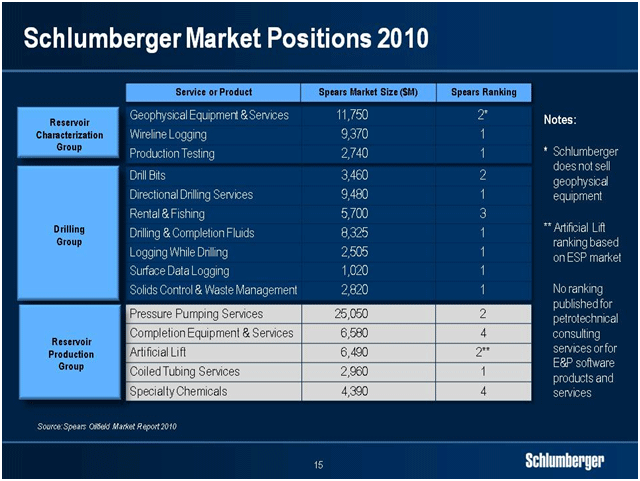
In other highly pertinent production-focused technologies, our advanced intelligent completion
products are having considerable success in managing reservoir contact. Furthermore, our position
in deepwater completions is strong.
In pressure pumping we are pleased with the progress that has been made in the North America
stimulation market. We are excited by the initial success of HiWay fracture stimulation, and we
occupy a leading position in the market in the rest of the world.
Lastly, Schlumberger leads the industry in the three principal methods of evaluating and treating
old wells to enhance production. These are wireline production services, slickline and coiled
tubing. In each of these markets we enjoy the number one position and are introducing increasingly
differentiated technologies such as the ACTive Technology Platform, a coiled-tubing system that
combines wireline-quality cased-hole measurements with coiled tubing to create a unique industry
product.
16
| Howard Weil Energy Conference 2011 | Keynote |
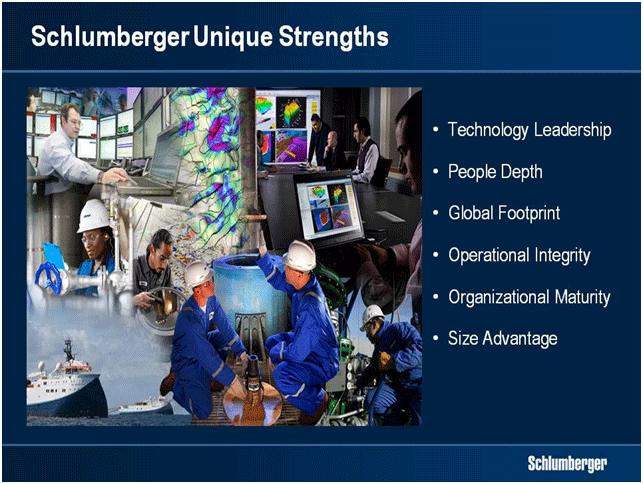
The application of our technology and our ability to grow is dependent on our building on a set of
strengths that are unique to Schlumberger. I do not have time to go through them all in detail and
therefore will concentrate today on technology leadership, global footprint, operational integrity,
and organization. Our commitment to a fully diverse equal opportunity workforce is well known and
forms a fundamental competitive advantage, as does our size.
From the company’s origins in wireline logging, we have over time expanded our technology portfolio
into a wide range of oilfield services and products, establishing leadership positions in most of
the markets we have entered. Today our portfolio is by far the broadest in the industry spanning 16
strong product lines.
By being able to offer the complete range of technologies in a workflow, we can eliminate this
misalignment and ensure that all the focus is kept on solving the customer’s challenge. This is why
we have organized and expanded our technology portfolio in line with the three main workflows of
our customers—reservoir characterization, drilling, and production.
17
| Howard Weil Energy Conference 2011 | Keynote |

Supporting this technology portfolio is a product development machine made up of more than 15,000
people in 65 centers around the world. The global footprint of these centers mirrors that of our
operations to enable close coordination between the two.
We invest more than USD 1 billion a year in product development ranging from ground-breaking
research that drives innovation to detailed engineering of our next-generation commercial products.
And today, our product development organization manages over 700 projects and supports more than
2,500 commercial products for our product lines.
In 2007, we conducted a comprehensive evaluation comparing our product and project performance
against leading companies in other technology driven industries. From this
work we concluded that we have huge potential for achieving better reliability and lowering the
cost of ownership for our products. These changes represent one part of the “Excellence in
Execution” program, which we started in 2007 and that will ensure that we widen our technology lead
going forward.
18
| Howard Weil Energy Conference 2011 | Keynote |
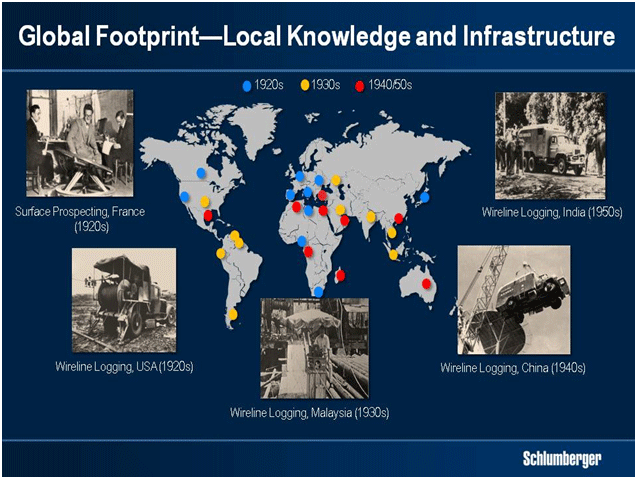
In terms of global footprint, our local knowledge and infrastructure is enormous and sustainable.
We operate in approximately 80 countries, many of which for more than 70 years. Our long and rich
history has created deep customer relationships and extensive local knowledge.
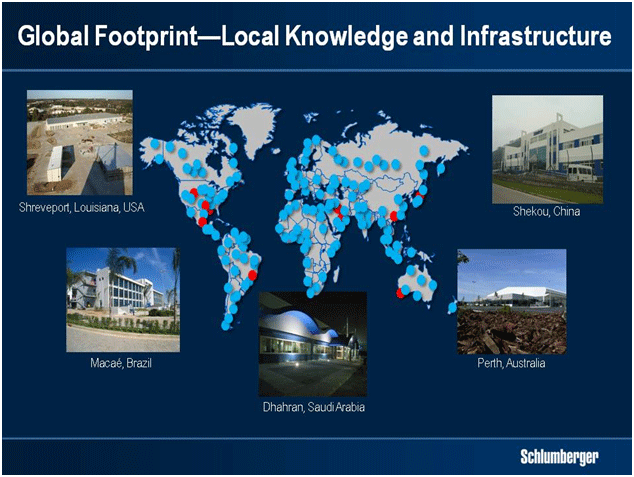
Throughout this time we have also made continuous investments in infrastructure and actively
recruited and developed local talent. For example in 2009 alone, we recruited over 4,000 engineers
and technicians globally, and we opened 9 new state-of-the-art facilities around the world.
19
| Howard Weil Energy Conference 2011 | Keynote |
In addition to having created strongholds in most of the oil and gas basins around the world, our
global footprint has other advantages. For example our operational flexibility allowed us in the
two months following the imposition of the Gulf of Mexico moratorium to move 580 of our deepwater
experts to new locations around the world.
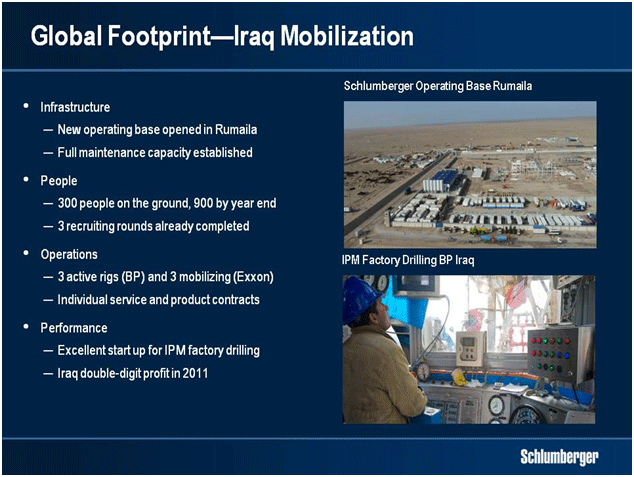
Iraq is another example of how we leverage our global footprint. Even though we were not the first
to return to Iraq due to security concerns, we have quickly taken the lead in terms of operations
on the ground. We have also won more than our fair share of the contracts so far awarded, and we
are doing well in terms of field operations.
Today we have three rigs drilling for BP, and we have another three being mobilized for ExxonMobil.
In addition, we have won a workover rig contract for ENI, as well as several individual products
and services contracts for other operators. Indeed in the last week we were awarded two further
products and services contracts valued at approximately $100 million.
20
| Howard Weil Energy Conference 2011 | Keynote |

Our position within the worldwide unconventional gas market is another example of leveraging a
global presence. In addition to our activity in North America we are engaged today in
unconventional gas projects in all parts of the world. Looking at shale gas in particular we are
convinced that the brute force approach established in North America will not be practical
overseas, either from a financial or an operational
standpoint and to exploit the full potential of shale gas globally, we will need to establish a
workflow and corresponding technology offering built around better evaluation and characterization
of shale gas reservoirs.
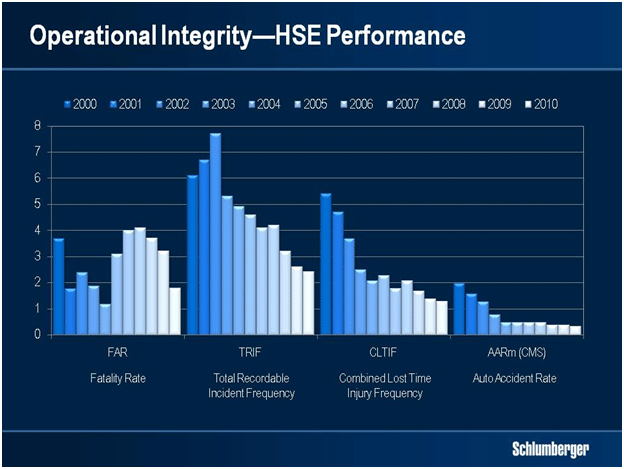
Moving to operational integrity, Schlumberger was one of the first in the industry to introduce a
QHSE management system back in the early 1990s. Over the past 20 years
21
| Howard Weil Energy Conference 2011 | Keynote |
we have established
industry-leading performance within the areas of quality, health, safety and environment. The
growing complexity and cost of oil and gas development is an opportunity to set ourselves further
apart in terms of operational integrity, which is all the more important following the Deepwater
Horizon incident.
Therefore in 2007 as part of the Excellence in Execution program, we started to look at what we
could learn from other leading industries in terms of operational quality and reliability.

This operational side of Excellence in Execution targets field and wellsite operations in terms of
people and process as well as product maintenance.
As part of our major drive towards better product maintenance we have over the past 4 years
invested more than USD 500 million in building new and larger operations bases in all parts of the
world. These new and larger bases enable standardization and more robust maintenance practices
based on LEAN principles. This leads to reductions in maintenance times and in numbers of
operational failures—factors that drive asset utilization. In North America pressure pumping for
example, we have doubled our asset utilization during the past year based on these principles.
Our focus on operational integrity is also closely linked to people competency and having the right
operational processes.
22
| Howard Weil Energy Conference 2011 | Keynote |
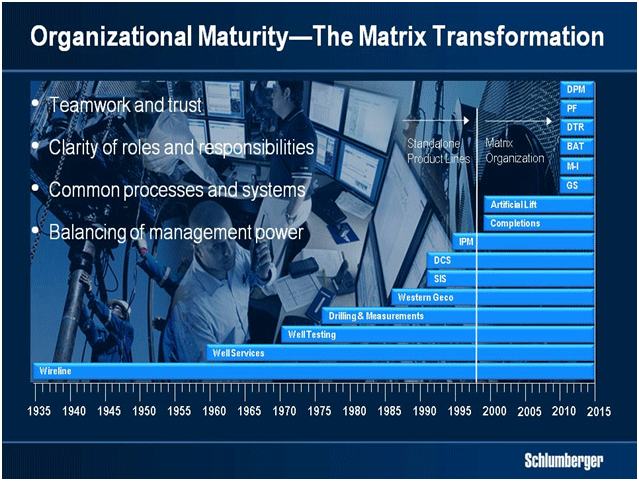
The maturity of our organizational model is also a distinct competitive advantage.
After having operated our product lines as standalone businesses since the company was founded, we
moved to a matrix organization in 1998 creating the original GeoMarket structure. Transforming a
set of standalone product lines into a matrix framework takes both time and investment, because it
requires a step change in teamwork and trust, more clarity of roles and responsibilities, as well
as common business processes and systems.
Thirteen years into the matrix transformation, we have successfully created a common customer
interface and grown our IPM business significantly through the GeoMarket organization. We have also
maintained or even strengthened the competitive position of all of our product lines.
But while we have made some progress on lowering the support costs and driving technology
integration, we still have significant upside potential in these areas, which we are actively
pursuing by giving the product lines management control of their day-to-day operations to allow the
GeoMarket organization to focus more on support costs and technology integration.
23
| Howard Weil Energy Conference 2011 | Keynote |
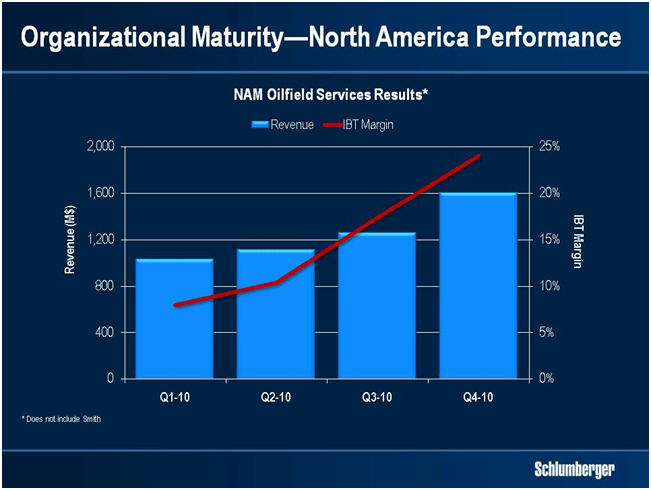
The recent restructuring of our North America operations is a good example of how we can use our
maturity to tune and optimize the organization in a non-traditional market.
The standard GeoMarket model was never optimized for North America land, which is quite different
from the traditional high-tier markets. Our restructuring created a separate focus on this business
by organizing the product lines into the workflows of reservoir characterization, drilling, and
production—and by centralizing overall business management as well as our shared support
organization.
At the beginning of 2010 we told you that our North America performance would be fixed in 12
months. While our fourth-quarter results benefited from year end and IPM impacts, it is clear that
we have made huge progress and that our ambition of being leaders in North America in both size and
margins is now within reach.
Before ending, I need to update you on events affecting the current quarter. Firstly I would remind
you as we did in the fourth-quarter conference call that the effect of year-end product deliveries
and multiclient data sales does not repeat in the first quarter. This year, the pattern of a short
drop in multiclient sales and the fluctuation in marine activity has been particularly pronounced.
I would remind you all that the year-end surge in Multiclient sales contributed about three cents
to our fourth-quarter earnings.
In addition, adverse weather materially impacted North America land and Australia, while the
earthquake in Japan had a minimal effect on the quarter. Minor revenue disruptions due to political
disturbances were felt in Ivory Coast, Yemen, Bahrain and Oman, and in Algeria due to logistics
from Tunisia. Significant revenue disruption occurred in Egypt, Tunisia and Libya. The total
after-tax effect of these events on the quarter is expected to be in the range of 8 to 10 cents.
While activity has returned to
24
| Howard Weil Energy Conference 2011 | Keynote |
normal in Egypt and Tunisia, we expect continued disruptions in
Yemen, no short-term return of activity in Libya and uncertainty at the current time over activity
in Bahrain.
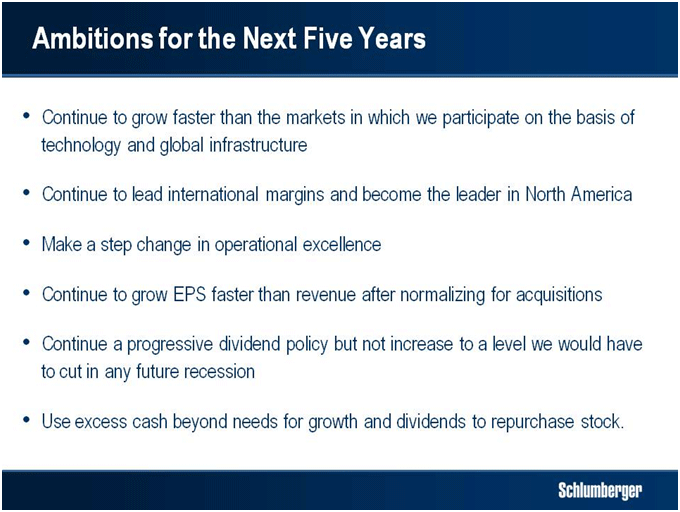
Schlumberger has doubled in size since 2005 and as the search for oil and gas becomes more global,
more intense and more difficult there is no reason why the company should not, overtime, double in
size again.
Today I have reviewed a very favorable macro scenario for Schlumberger that together with our
technology portfolio and our unique structural strengths will allow us to meet our stated
ambitions. We will be stronger for longer but it will mean raising the performance bar for our
customers, our shareholders and our competition.
Our leadership in measurements combined with our international presence will put us in the
forefront of exploring and developing unconventional gas plays outside North America.
Our position in IPM will provide a further leg to our growth—particularly in production
enhancement and field development.
In all our activities, and particularly in deepwater, the investment we have made in Excellence in
Execution will pay big dividends, and we will continue to produce exceptional financial results.
Ladies and gentlemen, this will be the last time I address this conference as CEO of Schlumberger.
I would like to thank everybody for the kind attention you have given to
25
| Howard Weil Energy Conference 2011 | Keynote |
my words over the last
eight years and to Howard Weil for continuing to attract so many investors to listen to them.
Finally, I am conscious of leaving behind me a management team that I have every confidence will be
able to execute the ambitions I have outlined.
Ladies and Gentlemen thank you for your attention.
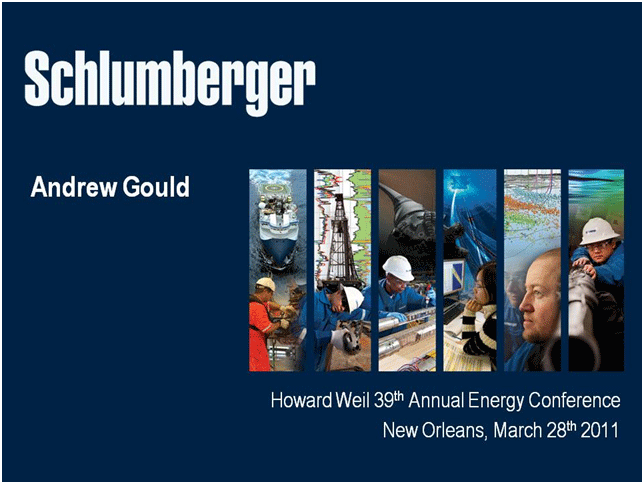

26
